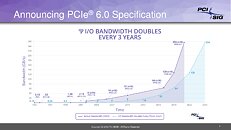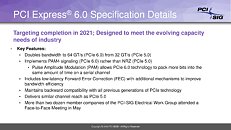Monday, February 24th 2020
PCI-Express Gen 6 Reaches Development Milestone, On Track for 2021 Rollout
The PCI-Express gen 6.0 specification reached an important development milestone, with the publication of its version 0.5 first-draft. This provides important pointers to PCI-SIG members on what features and design changes gen 6.0 hopes to bring, and what its all important number is - bandwidth. PCIe gen 6.0 quadruples per-lane bandwidth over gen 4.0 to 64 GT/s (double that of gen 5.0), resulting in bi-directional bandwidth of 256 GB/s in an x16 configuration.
The spec also introduces a new physical layer change, with PAM4 (pulse amplitude modulation) signaling replacing NRZ (non-return to zero), a key ingredient in the generational bandwidth doubling effort. Despite this, PCIe gen 6.0 retains backwards-compatibility with all older generations of PCIe, which could mean the PCIe slot on motherboards may not look any different. PCIe gen 6.0 also introduces FEC (forward error-correction), and has similar per-channel reach as PCIe gen 5.0. Our older article on Intel's proprietary CXL outlines a key feature of PCIe gen 5.0 besides its bandwidth doubling over gen 4.0 - scalability. Although targeting completion in 2021, it could take several more years for the technology to transcend enterprise computing segments and reach the client. PCI-SIG anticipates the need for gen 6.0 kind of bandwidth in the industry by 2025.
Source:
AnandTech
The spec also introduces a new physical layer change, with PAM4 (pulse amplitude modulation) signaling replacing NRZ (non-return to zero), a key ingredient in the generational bandwidth doubling effort. Despite this, PCIe gen 6.0 retains backwards-compatibility with all older generations of PCIe, which could mean the PCIe slot on motherboards may not look any different. PCIe gen 6.0 also introduces FEC (forward error-correction), and has similar per-channel reach as PCIe gen 5.0. Our older article on Intel's proprietary CXL outlines a key feature of PCIe gen 5.0 besides its bandwidth doubling over gen 4.0 - scalability. Although targeting completion in 2021, it could take several more years for the technology to transcend enterprise computing segments and reach the client. PCI-SIG anticipates the need for gen 6.0 kind of bandwidth in the industry by 2025.


33 Comments on PCI-Express Gen 6 Reaches Development Milestone, On Track for 2021 Rollout
Now the talk about 6.0, what for? :laugh:
Besides, new, improved standards are being developed all the time, no? So how is this different?
But isn't it refreshing that at least one component in your PC is so fast, you needn't worry about it for a few more years?
I am not sure where the problem is, though. Is the software too ancient or other components like the CPUs bottleneck the processing time and performance?
Unless programs start ballooning in size, there is only so fast a time you can load a 500MB piece of software.Where are you getting 20% from? A casual look at the crucial MX 500 of any other sata SSD would show random IOPS for read and write both top at most 110K/s. Most are below 100k. Meanwhile, the first generation of NVMe drives from samsung pushed reads to 300k/s, and second gens pushed the write above 200k/s. Currently, sabarent's rocket is showing 750K read and 700K write. The only random performance where NVMe does not significantly outperform SATA is 4KB random read/write, but there is only so much you can spead up reading/writing such small drives. Even then, the samsung 950 pro was 33% faster then a high end SATA SSD in 4k, and the 960 and 970 evos are faster then that.
I still wait 5 minutes for the game to load.
Edit: Here: www.anandtech.com/show/13761/the-samsung-970-evo-plus-ssd-review/6
I for one welcome new tech and relize we need new tech to be ready and availabe to all users so they can invent new ways to use it.
It's like Intel for years tried to convice main stream consumers that they had no need for more than four cpu cores out of greed so they could continue to peddle four core cpu's to main stream for insane money.
Now AMD has over run Intel and are changing the consumer landscape forever with up to 16 cores for main stream and 64 core for workstation for starters, near future they will go 32 core main stream and 128 core workstation.
I am looking forward to SSD with 32GB/s bandwidth and all the other ways we can invent ways to use this amazing new bandwidth to enhance our every day life.
As an engineering achievement, hats off when they set it in stone.
Where is my PCIE5 already? Where are my compatible gaming CPUs?
Come on now, PCI SIG, that's totally lame.
I guess it's fragmented all over the partition.
That's why I said 50 years.
5 years, at the very least, to adopt PCIe 4.0.
Then 15 years to happily use it.
And then 15 years more to use PCIe 5.0.
After all these years, maybe PCIe 6.0.
Sounds like your CPU/RAM are a much bigger bottleneck. What CPU/RAM do you have?For one thing, just because technology is "new" doesnt mean it is ready for consumer use, nor is it cheap enough for consumer use. New =! better. PCIe 5/6 have incredibly tight timings that, until a cheap method of implementation is established, would dramatically increase the costs of consumer motherboards with no real world benefit.
Lets bring up that quad core argument, shall we? Intel "convinced" consumers fo that, did they? No, I'm pretty sure the market decided that for itself. AMD offered 6/8 core mainstream CPUs for 9 years now, and only in the last 2 years or so did this start making any kind of difference in games. It's only been fairly recently that games have taken advantage of 6 cores in workloads, the vast majority STILL dont use more then 6, which is why many gaming focused builds use i5 9600k/r5 3600 CPUs. Only a single gen, the i 7000 series, really ignored the advancement of 6 core usage, up to that point there was no benefit to having more then 4 cores, as both intel's HDET platform and AMD's construction core showed. Ryzen happened to hit at the right time for multi core advancement.
You can clamor for 32GB/s of bandwidth all you want, but given that NVMe drives are already stupid fast, the question becomes why do you need more? Is a 3 second boot time just too slow for you? Keep in mind that most people have 125MB/s network speeds maybe 10% of that in internet speeds, and maybe 500MB/s over USB 3, all that NVMe speed is worthless outside of its own box. Internal storage stopped being the bottleneck with SATA III drives, and NVMe 4.0 drives are already ludicrous at 6GB/s, not to mention the 7-8 GB/s they will be hitting in a gen or 2.
We have a saying in english for someone who constantly jumps on new,expensive tech before it is useful or needed: "a fool and his money are soon parted"